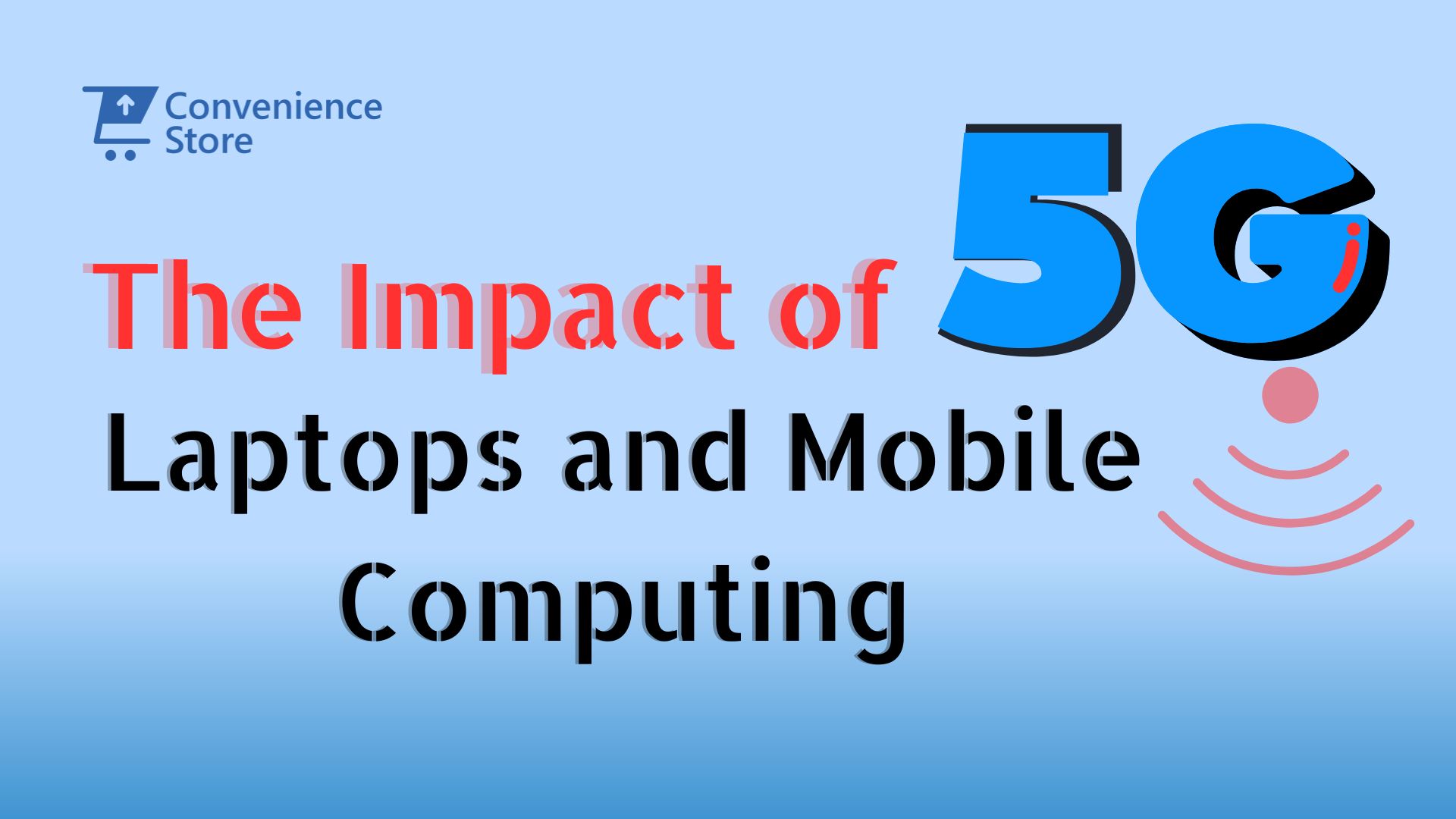The Impact of 5G on Laptops and Mobile Computing


The arrival of 5G technology marks a pivotal moment in the evolution of mobile connectivity, promising to transform the way we interact with our digital world. As the fifth generation of wireless technology, 5G is designed to provide unparalleled speed, reduced latency, and enhanced connectivity compared to its predecessors. These advancements hold significant implications for a wide range of devices, particularly laptops and mobile computing systems.
With 5G’s introduction, users can expect dramatic improvements in internet performance, from lightning-fast download speeds to near-instantaneous response times. This leap forward not only enhances everyday tasks but also enables innovative applications and services that were previously unattainable. For professionals and consumers alike, 5G opens up new possibilities for mobile computing, transforming how we work, play, and interact with technology.
In this comprehensive overview, we will explore the multifaceted impact of 5G on laptops and mobile computing. From its role in boosting connectivity and performance to its implications for cloud computing and remote work, we’ll examine how this groundbreaking technology is reshaping the digital landscape and paving the way for future innovations. As 5G continues to roll out globally, understanding its effects on mobile computing will be crucial for leveraging its full potential and staying ahead in an increasingly connected world.
Enhanced Connectivity and Speed
Increased Data Transfer Rates
5G revolutionizes data transfer rates, offering speeds up to 10 Gbps, a substantial leap from 4G’s maximum of around 1 Gbps. This increase in bandwidth translates to significantly faster downloads and uploads, reshaping how users interact with digital content. For DELL laptop users in Kenya, this means rapid access to large files, swift software updates, and uninterrupted media streaming. Mobile devices also benefit from faster app downloads and updates, providing a smoother and more efficient user experience.
Impact on Download and Upload Speeds
The enhanced data transfer rates of 5G impact various aspects of digital interaction:
- Download Speeds: Large files, such as high-resolution videos, software updates, and extensive data sets, can be downloaded almost instantaneously, eliminating wait times.
- Upload Speeds: Uploading content, including high-definition video streams and large files to cloud storage, becomes faster, facilitating efficient content creation and sharing.
Improved Reliability and Low Latency
How 5G Reduces Latency
5G addresses latency issues with advanced technologies such as network slicing and edge computing. Network slicing allows for the creation of virtual networks tailored to specific applications, reducing congestion and improving response times. Edge computing processes data closer to the user, further decreasing latency and enhancing real-time performance.
Benefits for Real-Time Applications and Services
- Gaming: The low latency of 5G enhances the gaming experience by providing real-time responsiveness, crucial for online and cloud gaming where every millisecond counts.
- Video Conferencing: Reduced latency improves video conferencing quality, making virtual meetings more effective by minimizing lag and improving communication clarity.
Expanded Mobile Computing Capabilities
Enhanced Performance for Mobile Devices
The integration of 5G technology significantly boosts the performance of mobile devices. With higher processing power and improved connectivity, laptops and smartphones can handle more demanding tasks and applications with ease. This results in smoother multitasking, quicker data processing, and enhanced overall device functionality.
New Possibilities for Mobile Applications and Services
- Augmented Reality (AR) and Virtual Reality (VR): 5G facilitates more immersive AR and VR experiences by providing the necessary bandwidth for high-quality graphics and real-time interactions. This opens up new opportunities in fields like education, entertainment, and training.
- Smart Applications: The increased connectivity and processing power support the development of advanced applications, such as those utilizing artificial intelligence (AI) and machine learning, leading to smarter and more capable mobile solutions.
Boosting Cloud Computing and Storage
Seamless Integration with Cloud Services
5G enhances the interaction between mobile devices and cloud services by offering faster data transfer speeds and reduced latency. This seamless integration allows for quicker access to cloud-based applications and storage, improving productivity and user experience.
Implications for Data Storage and Access
- Cloud Storage: The increased speed and reliability of 5G make cloud storage solutions more practical, allowing users to access and manage their data efficiently.
- Remote Access: Enhanced connectivity supports more effective remote access to cloud resources, enabling users to work with large datasets and applications from virtually any location.
Advancements in Remote Work and Collaboration
How 5G Supports Remote Work
5G provides a robust foundation for remote work by delivering high-speed, reliable internet access. This ensures that professionals can work from various locations without experiencing connectivity issues, enhancing flexibility and productivity.
Enhanced Video Conferencing and Collaboration Tools
- Video Quality: 5G enables high-definition video calls with minimal lag, improving the quality of virtual meetings and collaborative sessions.
- Collaboration: Real-time collaboration tools become more effective, allowing teams to work together seamlessly on documents and projects despite physical distance.
Emergence of New Applications and Use Cases
Augmented Reality (AR) and Virtual Reality (VR) Experiences
5G’s capabilities support the growth of AR and VR applications:
- Enhanced Immersion: The technology provides the necessary bandwidth for high-resolution, immersive experiences, benefiting sectors such as gaming, training, and virtual tourism.
- New Use Cases: Innovative applications in education and healthcare emerge, leveraging AR and VR for interactive learning and remote diagnostics.
Internet of Things (IoT) and Smart Devices Integration
5G supports a vast ecosystem of IoT devices, enabling:
- Smart Homes: Improved connectivity allows for seamless integration and management of smart home devices, enhancing automation and control.
- Industrial IoT: 5G facilitates advanced industrial applications, such as real-time monitoring and predictive maintenance, leading to increased efficiency and reduced downtime.
Impact on Battery Life and Power Efficiency
Energy Consumption of 5G-Enabled Devices
While 5G offers numerous benefits, it also increases energy consumption. Devices equipped with 5G technology may experience shorter battery life due to the higher power requirements for maintaining high-speed connectivity.
Innovations in Power Management
- Battery Optimization: Advances in battery technology and power management are crucial to address increased energy demands and extend device usage times.
- Efficient Chipsets: Development of more energy-efficient processors and components helps balance performance with power efficiency, mitigating the impact on battery life.
Security and Privacy Considerations
Potential Vulnerabilities Introduced by 5G
The complexity of 5G networks introduces new security challenges:
- Increased Attack Surface: The proliferation of connected devices and higher data transfer rates create more potential points of vulnerability.
- Data Privacy: Protecting personal and sensitive information becomes increasingly important as more data is transmitted over 5G networks.
Strategies for Securing 5G-Enabled Devices
- Enhanced Encryption: Implementing advanced encryption protocols ensures the protection of data transmitted over 5G networks.
- Robust Network Security: Comprehensive security measures are essential to safeguard network infrastructure and connected devices from cyber threats.
Challenges and Limitations of 5G Implementation
Current Limitations in 5G Infrastructure
The deployment of 5G faces several challenges:
- Infrastructure Requirements: Establishing a comprehensive 5G network requires significant investment in new infrastructure, including base stations and antennas.
- Coverage Gaps: Achieving widespread 5G coverage, especially in rural or underserved areas, remains a significant challenge.
Geographic and Economic Disparities in Access
- Urban vs. Rural Access: There is a noticeable disparity in 5G availability between urban centers and rural areas, affecting equitable access.
- Cost Barriers: The high costs associated with 5G infrastructure and devices may limit accessibility for some users, creating economic disparities.
Future Prospects of 5G in Mobile Computing
Long-Term Impact on the Technology Landscape
5G is expected to drive substantial changes in the technology landscape:
- Innovation: The technology will spur continued advancements and new applications, transforming various industries.
- Ecosystem Growth: The development of new industries and business models will be driven by enhanced connectivity and capabilities.
Predictions for Future Innovations and Developments
- Smart Cities: 5G will contribute to the growth of smart cities, with improved infrastructure and services enabled by advanced connectivity.
- Advanced Robotics: The technology will support more sophisticated robotics applications, including autonomous vehicles and industrial automation.
Comparison with Other Wireless Technologies
How 5G Stacks Up Against Wi-Fi 6 and Other Emerging Standards
- Speed and Capacity: 5G generally offers higher speeds and greater capacity compared to Wi-Fi 6, which is optimized for local network environments.
- Use Cases: While Wi-Fi 6 excels in high-density areas such as homes and offices, 5G provides broader mobile connectivity and supports a wider range of applications.
Complementary Roles of Different Wireless Technologies
- Integrated Approach: Both 5G and Wi-Fi 6 will coexist, each addressing different connectivity needs and scenarios.
- Optimized Use: Leveraging the strengths of each technology ensures a comprehensive and efficient wireless ecosystem.
Impact on Mobile Gaming and Entertainment
Enhanced Gaming Experiences with Lower Latency
5G’s low latency enhances mobile gaming by providing a more responsive and immersive experience:
- Reduced Lag: Gamers experience minimal lag, crucial for real-time online and cloud gaming.
- Cloud Gaming: Improved speeds support high-quality cloud gaming, enabling gamers to enjoy advanced titles on mobile devices.
Streaming High-Definition Content on the Go
- HD Streaming: Users can stream high-definition and 4K content without buffering, enhancing mobile entertainment experiences.
- On-Demand Access: Faster data transfer allows for seamless access to a wide range of media content, providing more flexibility and convenience.
Economic and Industry Implications
Impact on Tech Industry and Market Trends
5G is reshaping the technology industry:
- Market Growth: The demand for 5G-enabled devices and services drives market expansion and competition among tech companies.
- Investment Opportunities: Significant investments are being made in 5G infrastructure and related technologies, fueling innovation and growth.
Opportunities for Businesses and Developers
- Innovation: Businesses and developers have new opportunities to explore markets and applications enabled by 5G technology.
- Product Development: The enhanced capabilities of 5G lead to the creation of advanced products and services across various sectors.
Consumer Adoption and Market Trends
How Quickly Consumers Are Adopting 5G
Consumer adoption of 5G is rapidly increasing:
- Device Availability: The growing availability of 5G-enabled devices accelerates adoption rates.
- Network Expansion: Expanding 5G coverage enhances accessibility, encouraging more users to upgrade to 5G.
Trends in 5G-Enabled Device Sales and Market Share
- Sales Growth: Sales of 5G-enabled devices are rising, with manufacturers and service providers gaining significant market share.
- Market Trends: The shift towards 5G is influencing market trends, driving demand for new devices and services.
The advent of 5G technology is a game-changer for laptops and mobile computing, ushering in an era of unprecedented connectivity, speed, and performance. By offering dramatically increased data transfer rates, reduced latency, and enhanced reliability, 5G is set to revolutionize how we interact with digital content and services. Its impact extends across various facets of mobile computing, from improving real-time applications and remote work capabilities to enabling innovative uses of augmented and virtual reality.
As 5G continues to roll out, it promises to drive significant advancements in cloud computing, IoT integration, and mobile gaming, unlocking new possibilities and transforming industries. However, this progress is accompanied by challenges, including increased energy consumption, security concerns, and disparities in infrastructure deployment. Addressing these challenges will be crucial to fully realizing the benefits of 5G technology.
Looking ahead, the integration of 5G with other wireless technologies, such as Wi-Fi 6, will create a more cohesive and efficient digital ecosystem. The ongoing evolution of 5G will shape the future of mobile computing, driving innovation and opening new avenues for technological advancement.
In summary, 5G represents a pivotal leap forward in mobile technology, offering a wealth of opportunities and capabilities that will enhance our digital experiences and reshape the technological landscape for years to come. As consumers and businesses alike embrace this transformative technology, the full potential of 5G will continue to unfold, redefining what is possible in the world of laptops and mobile computing.




